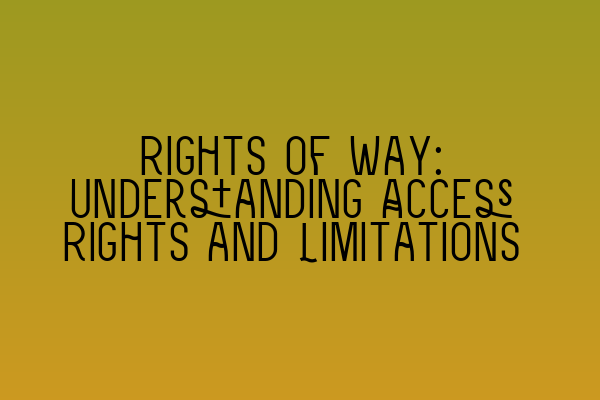Rights of Way: Understanding Access Rights and Limitations
Welcome to the SQE Property Law & Land Law blog! In today’s post, we will be delving into the fascinating topic of rights of way. Whether you are a property owner, a land developer, or someone looking to buy a property, understanding access rights and limitations is crucial to avoiding potential disputes and ensuring smooth transactions. Let’s dive right in!
What are Rights of Way?
Rights of way are legal rights that allow a person to pass through a particular piece of land owned by another party. These rights can be granted explicitly in a deed or implied based on common law principles. They are essential for providing access to properties and ensuring the efficient use of land.
There are two main types of rights of way:
- Public Rights of Way: Public rights of way are established by law and are typically designated for public use. These include footpaths, bridleways, and byways open to all traffic (BOATs). Public rights of way can be found on Ordnance Survey maps and must be maintained by the local authorities. They play a vital role in facilitating recreational activities and promoting public access to the countryside.
- Private Rights of Way: Private rights of way, as the name suggests, are rights that are granted for the private use of individuals. These rights are typically documented in deeds and are specific to particular properties or individuals. Private rights of way can include easements for vehicular access, pedestrian access, or the right to lay utility services.
It is important to note that private rights of way can have limitations and restrictions, which we will discuss in more detail later in this article.
Understanding Access Rights
When it comes to understanding access rights, it is crucial to review the relevant legal documents and conduct a thorough investigation of any potential limitations or restrictions that may exist. These documents may include property deeds, land registry records, and any existing agreements or covenants that affect the property.
Access rights can be granted either expressly or implicitly. Express rights of way are those that are explicitly documented in a deed or legal agreement. They leave no room for ambiguity and provide clear guidance on the scope and extent of the access rights.
On the other hand, implied rights of way can arise based on the circumstances and the nature of the land. For example, if a property is landlocked and has no alternative means of access, it may be implied that the property has a right of way over neighboring land to reach a public highway.
It is crucial to seek legal advice when determining access rights, as the interpretation of legal documents and the establishment of implied rights can be complex. Engaging a solicitor with expertise in property law will help ensure that your access rights are properly identified and protected.
Limitations and Restrictions
While rights of way provide important access to properties, it is essential to be aware of any limitations or restrictions that may be attached to these rights. Common limitations and restrictions include:
- Width Restrictions: Some rights of way may have specific width restrictions, which dictate the maximum width permitted for vehicular or pedestrian access. These restrictions aim to prevent excessive use or abuse of the right of way and to protect the surrounding land.
- Use Restrictions: Use restrictions can prohibit certain types of vehicles, activities, or behaviors on the right of way. For example, a right of way may be limited to pedestrian use only or may exclude the use of motorized vehicles.
- Maintenance Responsibilities: In some cases, the maintenance responsibilities for a right of way may be shared between the parties involved. It is essential to clarify these responsibilities and understand who is responsible for repairs, upkeep, and any associated costs.
- Termination and Modification: Rights of way can be terminated or modified under certain circumstances. For example, if a property owner decides to close off a right of way due to security concerns, an alternative access route may need to be negotiated.
Understanding these limitations and restrictions is crucial to avoiding disputes and ensuring that the access rights granted or enjoyed are fully compliant with legal requirements.
Resolving Disputes
Unfortunately, disputes regarding rights of way are not uncommon. They can arise due to various reasons, such as disagreements over the extent of the right of way, breaches of limitations or restrictions, or disputes over maintenance responsibilities.
If you find yourself embroiled in a rights of way dispute, it is essential to seek legal advice promptly. A skilled property law solicitor can help analyze the relevant legal documents, negotiate with the parties involved, and if necessary, represent you in court proceedings.
Remember, prevention is always better than cure. It is best to address any concerns or potential issues regarding access rights before they escalate into full-blown disputes.
Conclusion
In conclusion, understanding access rights and limitations regarding rights of way is essential for property owners, land developers, and buyers alike. By familiarizing yourself with the types of rights of way, the associated limitations and restrictions, and the proper procedures for resolving disputes, you can protect your rights and ensure a smooth and secure property transaction.
At SQE Property Law & Land Law, our team of property law experts can provide you with the necessary guidance and advice to navigate the complexities of rights of way. Contact us today to schedule a consultation and ensure that your access rights are properly understood and protected!
Related Articles:
